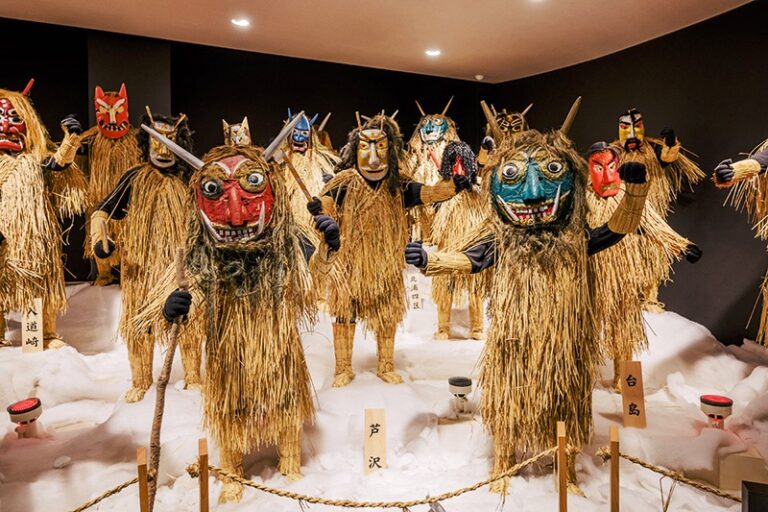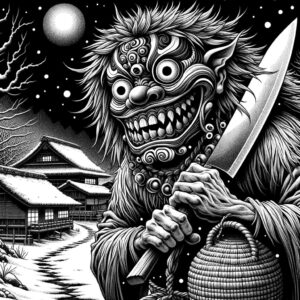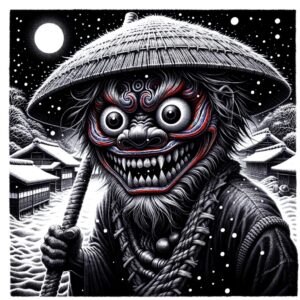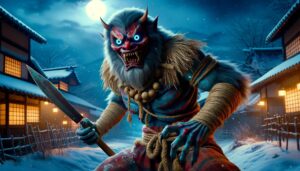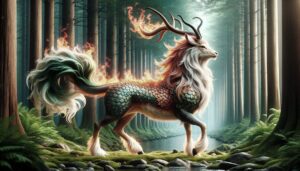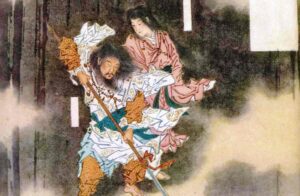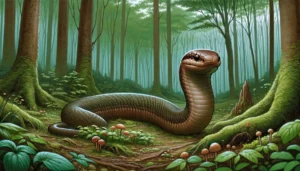Table of Contents
Namahage typically appear during the New Year’s Eve celebrations, when groups of men dress in fearsome masks and straw capes, going from house to house in their villages. They carry wooden tools and often brandish knives or hatchets to symbolize their intent to drive away evil spirits and ensure good fortune for the coming year.
The Namahage visit homes, scaring children and reminding them to be well-behaved and obedient. They may also ask about the family’s behavior and admonish those who have been naughty. In return for their warnings and blessings, they are often offered food and sake by the household.
The Namahage tradition serves both as a form of entertainment and as a way to instill moral values and discipline in children. It is an integral part of the rich folklore and cultural heritage of the Akita region in Japan, and Namahage festivals continue to be celebrated to this day.
The origin of the Namahage tradition is rooted in the folklore and history of Akita Prefecture in northern Japan. The exact origins of Namahage are somewhat debated and have several theories associated with them.
Ancient Rituals: Some believe that the Namahage tradition has its roots in ancient agricultural and shamanistic rituals. The masks and costumes used by Namahage performers resemble those used in traditional Japanese shamanism, suggesting a connection to early religious practices.
Protection Against Cold and Misfortune: In a region known for its harsh winters and heavy snowfall, the Namahage tradition may have developed as a way to entertain and unite the community during the long, cold nights. The belief in the supernatural power of these beings to ward off evil and misfortune could have led to their role in New Year’s festivities.
Influence of Other Cultures: Some theories suggest that the Namahage tradition may have been influenced by interactions with other cultures or regions, including China or Korea. These outside influences could have merged with existing local customs to create the Namahage as they are known today.
Regardless of their precise origin, Namahage have become an integral part of Akita’s cultural identity and continue to be celebrated and embraced as an important tradition in the region. The Namahage tradition has been recognized as an important intangible cultural asset of Japan and is included in UNESCO’s Representative List of the Intangible Cultural Heritage of Humanity.
Physical Description
Namahage are often depicted as fearsome and otherworldly creatures with distinct physical features. Their appearance varies slightly depending on the specific community and the masks and costumes used, but here are some common characteristics associated with Namahage:
Mask: Namahage masks are typically wooden and quite large, covering the entire face. They often have exaggerated, grotesque features, such as sharp teeth, wide eyes, and horns. The mask’s expression is meant to be intimidating and fearsome.
Cape: Namahage wear straw capes or garments made from straw or coarse fibers. These capes can be quite long and flow behind them as they move. The straw capes are meant to resemble the clothing of ancient Japanese mountain hermits or ascetics.
Footwear: Namahage often wear straw sandals or wooden clogs, which add to their distinctive appearance and make a distinct clacking sound as they walk.
Carrying Implements: Namahage are typically depicted carrying wooden tools or implements, such as a large knife, a hatchet, or a wooden mallet. These tools symbolize their role as protectors and enforcers of discipline.
Red and Blue Coloration: Some Namahage costumes feature red and blue colors. Red symbolizes the power to expel evil spirits, while blue represents the power to invite good fortune.
Height: In some communities, Namahage may be portrayed as tall and imposing figures, further enhancing their intimidating presence.
Namahage costumes and masks can vary from one community to another within the Akita region, so there may be some regional variations in their physical appearance. Despite their fearsome appearance, Namahage are an essential part of New Year’s festivities and are intended to bring blessings and good luck to households while also teaching moral lessons to children.
Namahage are portrayed as supernatural beings with distinct personalities in Japanese folklore. Their personalities are intended to serve specific cultural and educational purposes within the context of their traditional role in New Year’s celebrations and community life. Some key aspects of their personalities:
Fearsome and Intimidating: Namahage are intentionally depicted as fearsome and intimidating figures. They use their imposing appearance to instill a sense of awe and fear, especially among children. This fear is used as a means of discipline, encouraging good behavior and obedience.
Moral Instructors: Namahage are seen as moral instructors and enforcers. When they visit households during the New Year’s Eve festivities, they may question family members, particularly children, about their behavior over the past year. They praise those who have been well-behaved and admonish those who have been naughty, emphasizing the importance of good conduct and respect for elders.
Protectors: While they can be stern and intimidating, Namahage are also considered protectors of the community. They are believed to drive away evil spirits, misfortune, and bad luck. Their presence is seen as a way to ensure a fresh start and a prosperous year ahead.
Demanding but Fair: Namahage may demand offerings of food and sake from households as part of the New Year’s rituals. However, this demand is seen as a test of the family’s generosity and hospitality. If the family complies, it is believed that they will be blessed with good fortune.
Entertainers: Despite their fearsome appearance and serious role, Namahage often engage in playful and humorous interactions with the residents of the households they visit. This helps to balance their intimidating presence with entertainment and amusement, making the tradition enjoyable for all ages.
Namahage are mythical and supernatural beings in Japanese folklore, and they are typically depicted as having specific abilities and powers associated with their role in local traditions and customs. While these abilities may vary slightly depending on the specific beliefs of different communities, here are some common special abilities and characteristics often associated with Namahage:
Warding Off Evil Spirits: Namahage are believed to have the power to ward off evil spirits and protect households from misfortune. Their fearsome appearance is thought to frighten away malevolent forces that might bring harm to the community.
Blessing with Good Fortune: While they are intimidating figures, Namahage are also seen as bringers of good luck and prosperity. Their visits to households during the New Year’s festivities are meant to invoke blessings for the coming year.
Discipline and Morality: Namahage are considered moral instructors who encourage good behavior and discipline, especially among children. They may question family members about their conduct over the past year and praise or admonish them accordingly, promoting moral values within the community.
Testing Generosity: Namahage often demand offerings of food and sake from households during their visits. This serves as a test of the family’s generosity and hospitality. If the family provides offerings, it is believed that they will receive blessings in return.
Entertainment and Interaction: Namahage engage in playful and humorous interactions with the residents of the households they visit. They may engage in banter, sing songs, or perform comical acts to entertain and amuse people of all ages.
Symbol of Community Unity: Namahage also symbolize community unity and solidarity. The tradition of dressing up as Namahage and participating in New Year’s festivities fosters a sense of belonging and shared identity among community members.
Namahage are symbolic and cultural figures rather than actual supernatural beings with magical powers. Their abilities are part of the folklore and traditions of the Akita region in Japan, where they play a significant role in celebrating the New Year and passing down cultural values from one generation to the next.
Explanation of the Myth
The Namahage myth is deeply rooted in Japanese folklore and is associated with the customs and traditions of the Akita region in northern Japan. While there are variations of the myth, the most common version goes something like this:
Once upon a time, in a remote and snowy village in Akita Prefecture, the people lived in fear of evil spirits and misfortune that would visit their homes during the long, harsh winters. To protect themselves, the villagers decided to create the persona of the Namahage, a group of fearsome, supernatural beings.
The Namahage were believed to be powerful deities or ogres, and they were characterized by their grotesque masks, straw capes, and intimidating appearance. Each year, on New Year’s Eve, groups of men from the village would dress up as Namahage, donning the masks and costumes, and would go from house to house, visiting the residents.
During these visits, the Namahage would demand offerings of food and sake from the households. They would also question family members, especially children, about their behavior and conduct over the past year. Those who had been obedient and well-behaved would receive praise, while those who had been naughty or disrespectful would be admonished.
The primary purpose of the Namahage’s visit was to drive away evil spirits and ensure good fortune for the coming year. By intimidating the malevolent forces that might bring harm to the community, the Namahage played a protective role. Their strict moral teachings and discipline were also intended to promote good behavior and reinforce cultural values within the community.
Despite their fearsome appearance and stern demeanor, the Namahage were not solely figures of fear and intimidation. They were also entertainers who engaged in playful and humorous interactions with the residents, often singing songs and performing comical acts to amuse people of all ages.
The Namahage myth, therefore, serves multiple purposes within the community. It reinforces cultural values, promotes discipline and good behavior, protects against evil forces, and provides entertainment during the New Year’s celebrations. Over time, this tradition has become a beloved and cherished part of the cultural heritage of the Akita region, and Namahage festivals continue to be celebrated to this day, preserving the myth and its significance in Japanese folklore.
Relateed and similar creatures
There are several creatures and mythological beings from various cultures around the world that share similarities with Namahage in terms of their role, appearance, or cultural significance. For examples:
Krampus (Austrian and Bavarian Folklore): Krampus is a legendary figure in Central European folklore, particularly in Austria, Bavaria, and other German-speaking regions. Like Namahage, Krampus is associated with the Christmas season and is often depicted as a horned, devil-like creature who punishes naughty children while Saint Nicholas rewards the well-behaved ones.
Belsnickel (Pennsylvania Dutch Tradition): Belsnickel is a character from Pennsylvania Dutch folklore in the United States. He is similar to Krampus in that he visits homes during the Christmas season to reward good children with treats and punish naughty children with pranks or switches.
Zwarte Piet (Dutch and Belgian Tradition): In Dutch and Belgian folklore, Zwarte Piet (Black Pete) is a companion of Saint Nicholas who assists with delivering gifts to children. Zwarte Piet is often depicted in colorful clothing, but like Namahage and Krampus, he can have a somewhat intimidating appearance with dark skin and blackened faces.
Knecht Ruprecht (German Folklore): Knecht Ruprecht is another German Christmas character who is similar to Krampus. He is often portrayed as a tall, bearded man who accompanies Saint Nicholas and punishes naughty children by carrying a switch or rod.
Yule Goat (Nordic Tradition): In Scandinavian and Nordic folklore, the Yule Goat is a mythical creature associated with the Christmas season. Depending on the region, the Yule Goat may either be a benevolent gift-bringer or a mischievous figure who plays pranks.
Namazu (Japanese Folklore): While not directly related to Namahage, the Namazu is a giant catfish in Japanese folklore that is said to cause earthquakes when it thrashes around. Some festivals and customs in Japan involve rituals to appease the Namazu, emphasizing the idea of warding off disaster.
These creatures and traditions often serve similar cultural and moral purposes, such as encouraging good behavior in children, warding off evil spirits, and bringing blessings or gifts during holiday celebrations.
FAQ
What is Namahage?
Namahage is a mythical creature from Japanese folklore.
Where is Namahage traditionally celebrated?
Namahage is primarily celebrated in the Akita region of northern Japan.
When do Namahage visit households?
Namahage visit homes during New Year's Eve.
Why do Namahage visit homes?
They visit to drive away evil spirits, bless households, and teach moral lessons.
What do Namahage wear?
They wear masks, straw capes, and often carry wooden implements.
What role do Namahage play in the community?
Namahage promote discipline, good behavior, and community unity.
What happens during a Namahage visit?
They question family members, offer blessings, and may demand offerings.
Is Namahage a religious figure?
No, Namahage is a cultural and folklore character, not a religious one.
Are Namahage meant to be frightening?
What is the significance of the straw capes worn by Namahage?
The straw capes are symbolic of traditional clothing and asceticism.
Do Namahage have specific powers or abilities?
They are believed to protect against misfortune and bring good luck.
Are there different variations of Namahage in Japan?
Yes, the appearance and customs associated with Namahage may vary by region.
Is the Namahage tradition still practiced today?
Yes, Namahage festivals and customs continue to be celebrated in some parts of Japan.
Do children fear Namahage?
Yes, children may be frightened by their appearance, but the fear is part of the tradition.
How do families prepare for a Namahage visit?
Families often have food and sake ready as offerings for the Namahage.
Is Namahage a character in Japanese mythology?
No, Namahage is more a part of folklore and local customs than traditional mythology.
Are there any modern adaptations or variations of the Namahage tradition?
Some communities have adapted the tradition to be more family-friendly and less intimidating.
